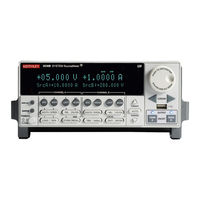Tektronix KEITHLEY System SourceMeter 2612B Manuals
Manuals and User Guides for Tektronix KEITHLEY System SourceMeter 2612B. We have 1 Tektronix KEITHLEY System SourceMeter 2612B manual available for free PDF download: Reference Manual
Tektronix KEITHLEY System SourceMeter 2612B Reference Manual (946 pages)
Brand: Tektronix
|
Category: Measuring Instruments
|
Size: 34 MB
Table of Contents
-
-
Welcome5
-
-
Installation27
-
LOCAL Key52
-
-
Front Panel57
-
Cursor Keys60
-
Range Keys60
-
Rear Panel62
-
Power Module67
-
Beeper76
-
-
Display Mode77
-
-
-
Remote Limit96
-
Sink Mode97
-
NPLC Caching100
-
Ohms Ranging108
-
Ohms Sensing110
-
Saved Setups116
-
-
Safety Shield135
-
Noise Shield139
-
Test Fixture141
-
Floating a SMU142
-
-
Range149
-
Digits154
-
Speed155
-
Sweep Operation157
-
List Sweeps163
-
Pulse Duty Cycle165
-
Relative Offset169
-
Filters172
-
Filter Types172
-
Response Time173
-
Script Example179
-
In this Section181
-
Buffer Status193
-
-
-
In this Section197
-
-
Action Overruns206
-
-
Timers209
-
Event Blenders216
-
-
Digital I/O231
-
Interlock Line233
-
Operation239
-
In this Section241
-
Contact Check262
-
Pulse Width268
-
Maintenance269
-
In this Section269
-
Beeper Control278
-
Data Queue279
-
Error Queue280
-
Event Log280
-
Reading Buffer285
-
SMU Calibration288
-
-
-
In this Section299
-
What Is a Script300
-
Manage Scripts301
-
Run Scripts306
-
Autoexec Script308
-
Autorun Scripts308
-
-
What Is Lua314
-
Lua Basics314
-
Variable Types317
-
Loop Control325
-
While Loops325
-
For Loops327
-
-
-
Rename a Script346
-
-
TSP-Link Nodes353
-
Assigning Groups361
-
TSP-Net364
-
Example Script366
-
In this Section369
-
Placeholder Text369
-
Syntax Rules370
-
Command Usage373
-
Command Details373
-
Example Section374
-
TSP Commands375
-
Display Screen446
-
Format.data468
-
Gpib.address475
-
Serial.databits555
-
Serial.parity557
-
Binary Value712
-
Bit B7 B6 B5 B4712
-
Decimal712
-
Weights712
-
Example713
-
-
Example 1718
-
Polling for Srqs795
-
Next Steps801
-
In this Appendix803
-
In this Appendix839
-
LAN Speeds852
-
Duplex Mode853
-
Common Commands863
-
In this Appendix863
-
Command Summary863
-
Status Model867
-
Command Queue869
-
Output Queue869
-
In this Appendix895
-
Status Word904
-
Advertisement
